The Munsey Building (1905-1980) Remembered
Frank Munsey was a Gilded Age capitalist—robber baron, if you will—who had a major influence on the publishing business at the beginning of the twentieth century. He is credited with perfecting printing processes that could use extremely low-quality “pulp” paper to produce periodicals that were both dirt-cheap and filled with enough racy fare to be widely popular. Thus was born the era of pulp fiction. Munsey went on to buy, sell, and merge many newspapers throughout the country, often for his own profit but at the expense of the publication’s very existence.
One of Munsey’s newspaper acquisitions was the Washington Times, founded by a group of Washington printers in 1894 and acquired by Munsey in 1901 (note: there is no connection between the original Times and the current newspaper of the same name, which began in the 1980s). In 1905, Munsey built a grand new skyscraper of an office building at 1329 E Street, N.W., to house his newspaper. The structures on this block essentially faced Pennsylvania Avenue at the time. The new Munsey Building was just a few doors down from the Richardson-Romanesque Washington Post building and a couple of blocks west of the Evening Star building, so all the important journalists of the early 1900s were in close proximity along this stretch of the Avenue.
As seen in these postcards, the original building of 1905 (the tall building with the elaborate cornice) had a fairly ornate façade, which was redone and simplified sometime between 1910 and 1915. (The Historic American Buildings Survey description of the Munsey building, compiled in 1979, states that only one image was extant at that time of the building in its original configuration, but these postcards, from about 1908, also show the original configuration.) In 1915, an addition was built that more-or-less doubled the size of the building, extending it all the way to the gable-roofed Washington Post building on the left.
The Munsey Building was unquestionably meant to be a prestige office building, and Munsey spared no expense in attaining that goal. He hired the premiere architectural firm, McKim, Mead, and White of New York City, to design the elegant 12-storey Italian Renaissance Revival building and used high-quality materials throughout. The interior banking room on the first floor had marble paneled walls punctuated by marble Roman Doric pilasters and had luxurious marble, wood, and brass detailing. The upper corridors had black and red marble bands in the floor design marking the entrances to offices. Even the restrooms had marble wainscoting. When selling the building to his own banking company in 1913, Munsey published an editorial defending his investment in the building: “The Munsey Building was built by the Fuller Company, and at a cost of close to sixty cents a cubic foot—sixty cents, mind you, against thirty or thirty-five cents, the cost per cubic foot of putting up fairly good office buildings, but not buildings of real class or genuine in quality.”
The culprit in our story is the Pennsylvania Avenue Development Corporation (PADC), chartered by Congress in 1972 to redevelop the area around Pennsylvania Avenue between the Capitol and the White House. In its 1974 plan, the PADC essentially damned the entire block where the Munsey stood with the statement that “(t)here are few structures of landmark quality in this square.” The Munsey Building itself was dismissed as a “well-defined, early 20th Century commercial building” that was “somewhat outdated by competitive standards.” In 1979, the PADC bought the then-vacant building with the intention of demolishing it so that a new hotel and office complex could be constructed. I took the following picture of the block in early 1980, when work was underway to build Freedom Plaza and the building was being prepared for demolition.
There was certainly opposition to the move. The courts temporarily blocked demolition while lawyers for Don’t Tear It Down, the predecessor of the D.C. Preservation League, tried desperately to save the Munsey. The PADC essentially argued that it had special status and powers to do anything consistently with its approved plan for Pennsylvania Avenue, and the courts ruled that its actions didn’t conflict with the Historic Preservation Act. The demolition proceeded.
I was there again in the fall of 1980, on a weekend when demolition was taking place and took these photos of the demolition and the spectators in Freedom Plaza who were transfixed by it.
It seems worth considering now, thirty years later, what, if anything, has changed, and whether this shocking and wanton destruction would take place again today in similar circumstances. Perhaps it’s those circumstances that are the key. In 1979, historic preservation and reuse downtown were not yet well-established, and many still worried about when or how downtown would be revitalized. Perhaps, then, it was just lack of faith—or imagination, or courage—on the part of the PADC as to what was the true potential of an historic structure like the Munsey. In hindsight, we probably can unanimously agree that a sensitive restoration and reuse of the Munsey would have been a far better amenity for Pennsylvania Avenue than the bland hotel building that sits there today.
To receive Streets of Washington by email click on this link and choose "Get Streets of Washington delivered by email" from the Subscribe Now! box on the upper right hand side of the page.
One of Munsey’s newspaper acquisitions was the Washington Times, founded by a group of Washington printers in 1894 and acquired by Munsey in 1901 (note: there is no connection between the original Times and the current newspaper of the same name, which began in the 1980s). In 1905, Munsey built a grand new skyscraper of an office building at 1329 E Street, N.W., to house his newspaper. The structures on this block essentially faced Pennsylvania Avenue at the time. The new Munsey Building was just a few doors down from the Richardson-Romanesque Washington Post building and a couple of blocks west of the Evening Star building, so all the important journalists of the early 1900s were in close proximity along this stretch of the Avenue.
As seen in these postcards, the original building of 1905 (the tall building with the elaborate cornice) had a fairly ornate façade, which was redone and simplified sometime between 1910 and 1915. (The Historic American Buildings Survey description of the Munsey building, compiled in 1979, states that only one image was extant at that time of the building in its original configuration, but these postcards, from about 1908, also show the original configuration.) In 1915, an addition was built that more-or-less doubled the size of the building, extending it all the way to the gable-roofed Washington Post building on the left.
The Munsey Building was unquestionably meant to be a prestige office building, and Munsey spared no expense in attaining that goal. He hired the premiere architectural firm, McKim, Mead, and White of New York City, to design the elegant 12-storey Italian Renaissance Revival building and used high-quality materials throughout. The interior banking room on the first floor had marble paneled walls punctuated by marble Roman Doric pilasters and had luxurious marble, wood, and brass detailing. The upper corridors had black and red marble bands in the floor design marking the entrances to offices. Even the restrooms had marble wainscoting. When selling the building to his own banking company in 1913, Munsey published an editorial defending his investment in the building: “The Munsey Building was built by the Fuller Company, and at a cost of close to sixty cents a cubic foot—sixty cents, mind you, against thirty or thirty-five cents, the cost per cubic foot of putting up fairly good office buildings, but not buildings of real class or genuine in quality.”
.jpg) |
| The Munsey Building in 1919, after it was nearly doubled in size. (Source: Smithsonian Archives via Flickr) |
 |
| The Munsey Building in 1980 with netting on the east side in preparation for demolition. (Photo by the author.) |
I was there again in the fall of 1980, on a weekend when demolition was taking place and took these photos of the demolition and the spectators in Freedom Plaza who were transfixed by it.
It seems worth considering now, thirty years later, what, if anything, has changed, and whether this shocking and wanton destruction would take place again today in similar circumstances. Perhaps it’s those circumstances that are the key. In 1979, historic preservation and reuse downtown were not yet well-established, and many still worried about when or how downtown would be revitalized. Perhaps, then, it was just lack of faith—or imagination, or courage—on the part of the PADC as to what was the true potential of an historic structure like the Munsey. In hindsight, we probably can unanimously agree that a sensitive restoration and reuse of the Munsey would have been a far better amenity for Pennsylvania Avenue than the bland hotel building that sits there today.
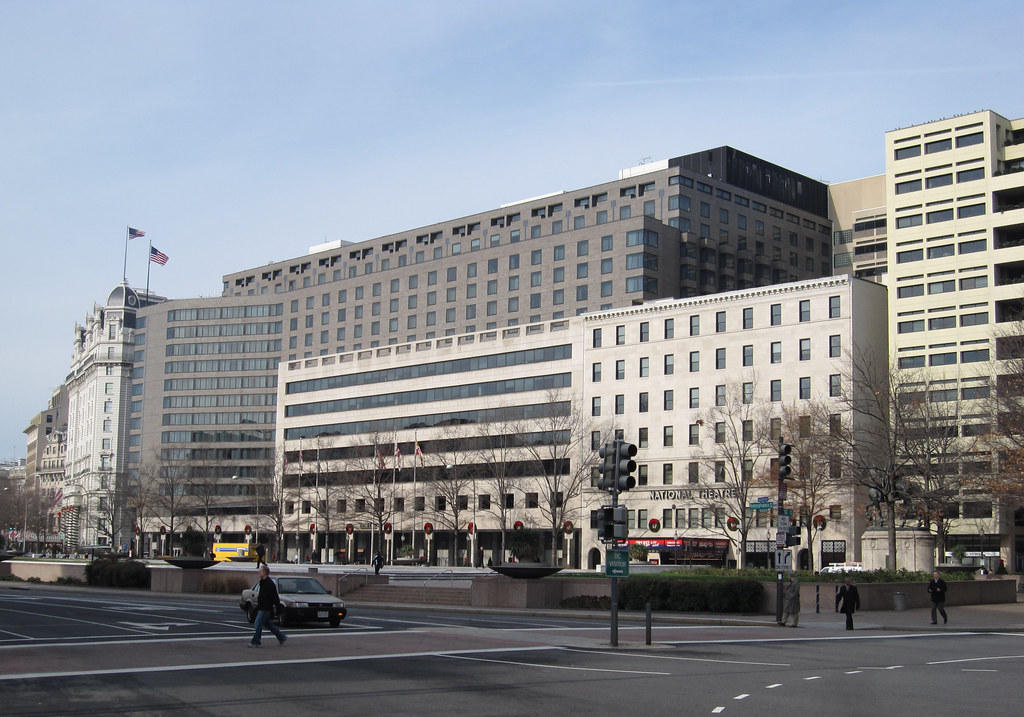 |
| The site as it looks today (photo by the author). |
* * * * *
To receive Streets of Washington by email click on this link and choose "Get Streets of Washington delivered by email" from the Subscribe Now! box on the upper right hand side of the page.
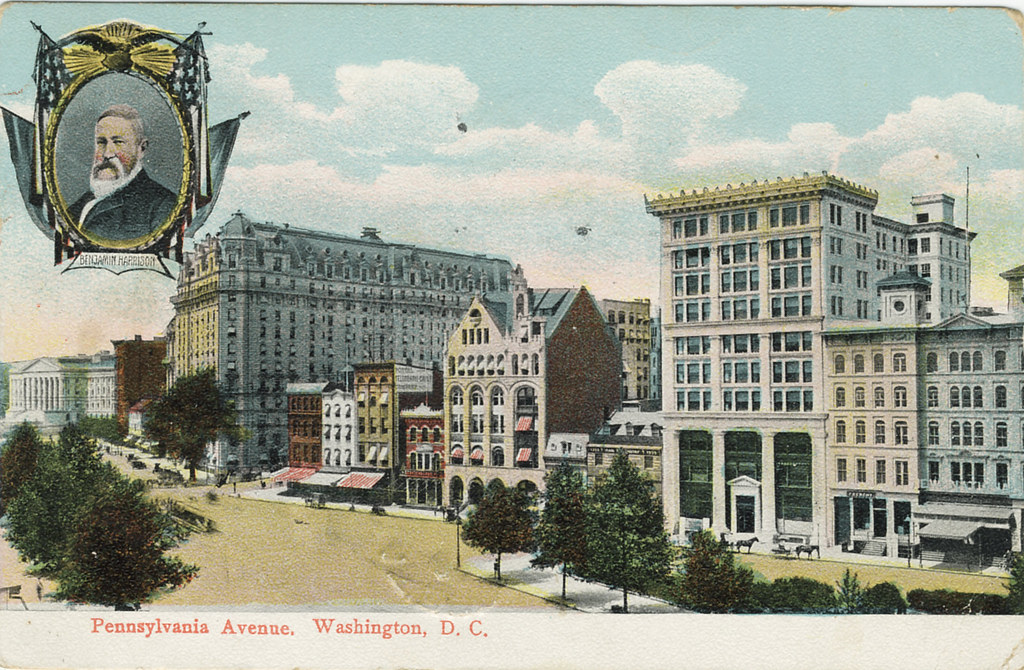

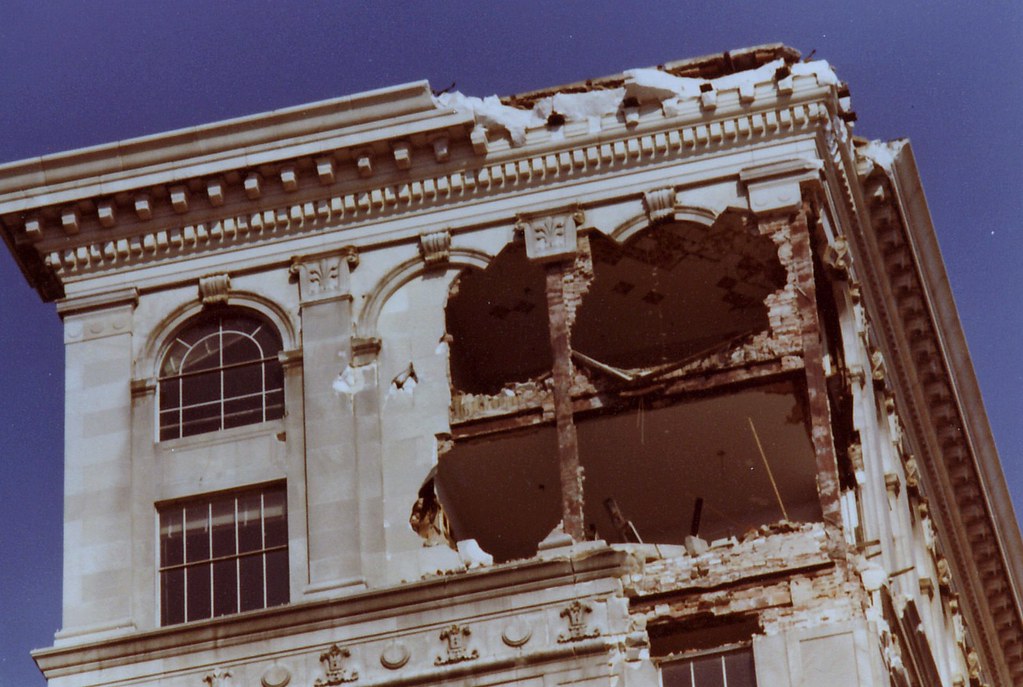
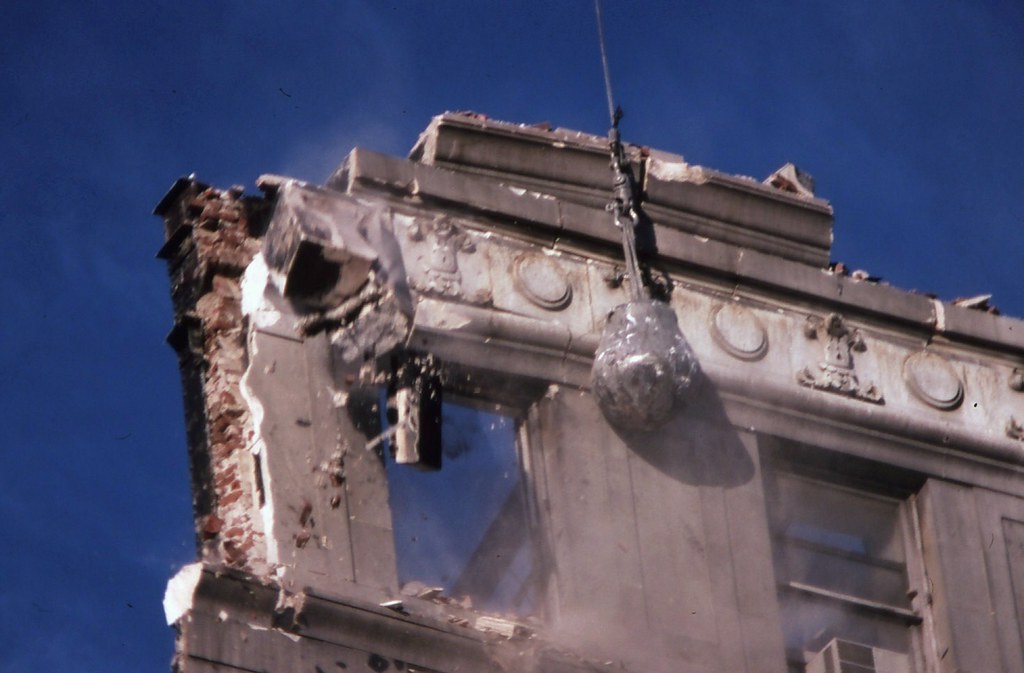
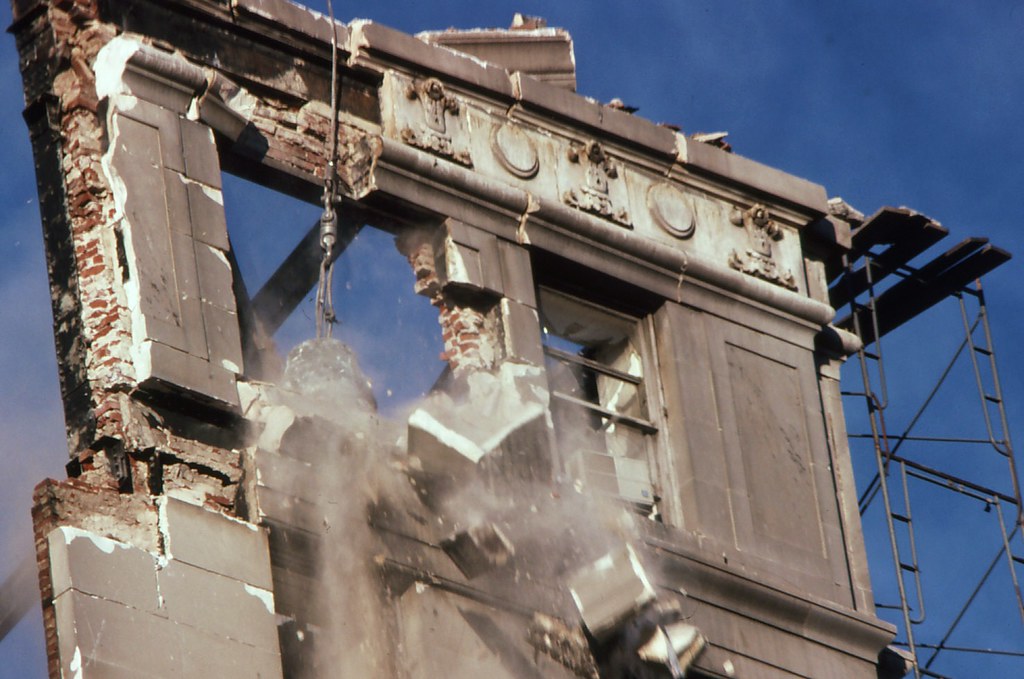
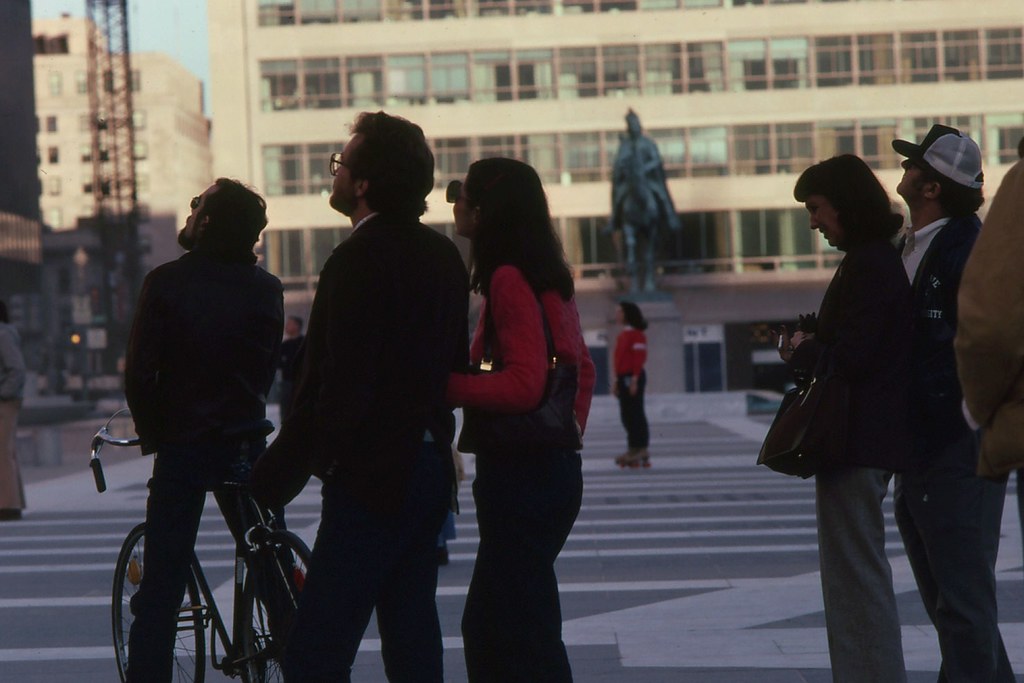
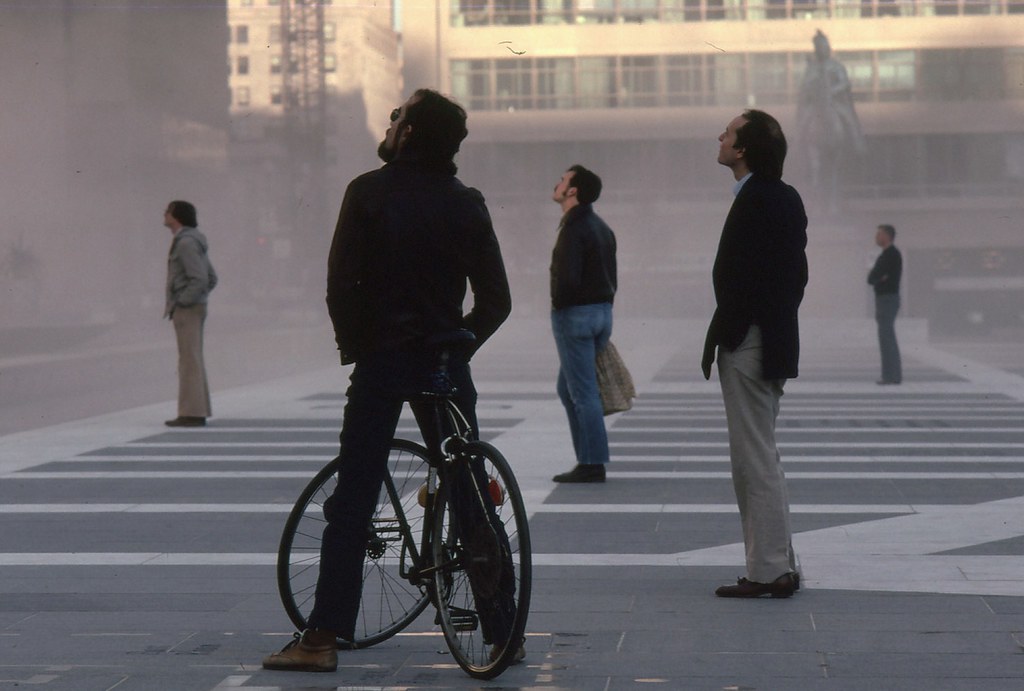


Amazing blog entry. I was here in 1980 but simply have no memory of this building or of its demolition. Goode didn't document this building in "Capitol Losses" and thus my ignorance of its history (although I am very familiar with the vintage postcard). Thank you for educating me!
ReplyDeleteMr. Goode doesn't mention it in "Capitol Laosses", perhaps, because it was still there when the book was published in 1979
Deletebeautiful shots of a terrible event..
ReplyDeletePeter Sefton
Nicely done - I've linked to this entry from a 1907 view of the block:
ReplyDeletehttp://www.flickr.com/photos/rock_creek/2091429739
The Munsey Building was also the subject of an early amendment of the Height of Buildings Act as it concerned properties near certain intersections.
ReplyDeleteBrewers and speculator/builders Robert Portner and Albert Carry purchased the old Hotel Lawrence at that site in March 1902, ostensibly to build a "mammoth new hotel" to be designed by C.A. Didden (although no plans were ever drawn up). Paying dearly for the property, they then argued that a new commercial building there should be able to reach 130 feet, given that the property faced Pennsylvania Avenue across a reservation. Of course, more than half of the frontage was along the intervening E Street, limiting the height to 90 feet.
Unconvinced by some of the partners' arguments, yet sympathetic to both the project and the need to clarify the height issue at intersections, the District Commissioners petitioned Congress for an amendment to the Height Act to disregard intervening public reservations when calculating the maximum adjacent street widths. Successful in having increased the paper value of the property greatly, Portner and Carry flipped it to Munsey at the end of the year.
I assume this is the same Munsey Building that is the title of Chapter 32 in volumn 1 of Robert Caro's LBJ biography "The Path to Power." Thanks for the page.
ReplyDeleteoops - please make that 'volume' - it's late. :)
ReplyDeleteThanks very much for the LBJ reference--it does indeed appear to be the same buidling.
ReplyDeleteThank you so much for this info - today I was remembering "years" ago which brought me to the Munsey Bldg and I googled it- I was a legal secretary for ten years in the Munsey Bldg.- a young attorney opened his office across the hall from us. We became friends and were married within six months. I have many memories of DC and this location. Yes, there were patent lawyers in the bldg.
ReplyDeleteI understand from "The History of Woman Suffrage" (vol 5 p 412) that the Munsey Building is where the National American Woman Suffrage Association moved its HQ in early 1914. I don't know if it remained there till women got the vote in 1920, because a photo here
ReplyDeletehttp://webcache.googleusercontent.com/search?q=cache:Q8trXIlhxcEJ:www.nwhm.org/online-exhibits/progressiveera/suffrage.html+nawsa+headquarters&cd=1&hl=en&ct=clnk&gl=us
doesn't look as if it's the same place. However, if they operated here even briefly, it's another Civil Rights for Women building that has bit the dust and I appreciate your documentation of it.
What is also sad about this,
Additional research has shown that the National American Woman Suffrage Association was in new headquarters by late 1916 or early 1917, so the most they were in the Munsey Building was just about 3 years, from early 1914 to at most before April 1917 and likely just to late 1916. The photo link (in my previous comment) is not the Munsey Building.
ReplyDeleteThis is indeed the same building from which LBJ dispersed thousands of dollars to loyal New Deal democrats that backed FDR in the 1940 election campaign.
ReplyDeleteI declined the invitation to inelegance to watch that building being destroyed. By that time just hearing 'padc' set me off. I never set foot in it but passed it by countless times with a smile, with my abiding love for old buildings, though saddened at its decrepitude. While I have grown to at least tolerate the presence of that giant slab Western Plaza ["freedom" my Aunt Minnie's sagging ones!], I have itched for the removal of that crappy hotel ever since. May I live to see it die the miserable death it [and sooo many others] deserves.
ReplyDeleteAccording to Girl Scout History, the
ReplyDeleteMunsey (Trust) Building, Washington D.C. was briefly the headquarters for Girl Scouting from June 1, 1913-1916.
When I was still in high school in early 1956, I did some part-time "grunt" work for a law firm on the sixth floor. I don't remember the name--does anyone recall it?
ReplyDeleteI remember it well from my childhood. My grandfather's law office was located there. One of my earliest memories was riding on the elevator with the wonderful old black elevator operator.
ReplyDeleteMr. Wideman, I too remember it from my childhood and the old black elevator operator who was always so kind to me as a child . . .My dad owned the "Riordan Agency of the John Hancock life ins co. located in the bldg.
Deletethere is also a Martin A. Gruber photo in the Smithsonian Archives here http://www.flickr.com/photos/smithsonian/4920327240/in/set-72157624790639858/
ReplyDeleteThanks for the link. I've added the photo to the main text.
DeleteThe Klan also had it's HQ in the building in 1922. This may have been the local office for the DC branch because their national HQ was in the Southern Bldg at 15th and K.
ReplyDeleteI don't have any idea where the Klan might have had quarters, but the Southern Building is at 15th and H. There's the Southern Railway Building at 15th and K, facing the northwest corner of McPherson Square.
DeleteMy mother worked there in the late 50s-early 60s, as a secretary to Elsworth Mosher, partner in Stevens, Davis, Miller and Mosher. At that time I believe it was the third or fourth largest patent law firm in the city. Bill Schoenborn
ReplyDeleteI worked for a small patent law firm on the 11th floor from mid-1961 through about 1970. I remember the law firm Stevens, Davis, Miller and Mosher and seem to recall they were on the sixth floor. The elevators were operated by women wearing white gloves. At that time the Patent Office was still housed in the Commerce Department Building which was very convenient for patent law firms. What made me think of the Munsey Building now is in reading Doris Kearns Goodwin's book "The Bully Pulpit".
ReplyDeleteI found it very interesting to learn that in the 1912 election campaign Teddy Roosevelt set up his offices on the tenth floor of the Munsey Building; while William Taft's campaign headquarters were in the Raleigh Hotel, 1111 Pennsylvania Avenue. How Washington has changed!
This building was built to stand forever. Tearing it down was an absolute crime! I remember marveling at the construction when a friend of mine and I went to the demolition sale. They were selling anything you could get out of it. He and I pried white marble panels down from walls on different floors. I managed to remove around a dozen window and door cornices. At least two of these came from the top floor, beautiful unpainted oak, about seven feet long. I also got some pilasters to go with them. I installed these in the house I was living in at the time, 7404 Oak Lane in Chevy Chase, MD. The house was sold in 2003 and was going to be totally remodeled, so I removed all of the Munsey architectural parts and eventually reinstalled them in the Rossdhu Castle gatehouse, where my parents lived at 3207 Woodbine St. in Chevy Chase, MD.
ReplyDeleteAfter my father died in 2001, I moved into the gatehouse and finally got the last of the cornices up and used in an addition and restoration project. Unfortunately, we had to sell the house in 2014.
Incidentally, two of the four 11 foot Tudor style candelabra that graced the Folger Library's great hall are outside under the Tudor gate. They had been removed to provide open room because they were spaced down the center of the hall. Why they couldn’t have moved them to the sides baffles me to this day. They took them apart and boxed them up and stored them in the basement of the Library of Congress. When they started restoration of the L of C @1990 they were in the way, so they sold them to Maurice Electric and Pat Stanley, the showroom manager arranged the deal. Two of them went to Marvin Kogod’s house in Boca Raton. He with Tom Green owned Maurice. I managed to buy the other two. I worked in their showroom for 33 years, 1981 - 2014. After Mr. Kogod died, his two were auctioned at Weschler’s on E St.,NW in 2013 (?) for about $32,000 for the pair. They were made by the J.E. Caldwell Co that also made the hanging lantern in the portico of the White House.
What a waste! What they replaced that with does not even approach the quality of the Munsey Building. DO you know when the neighboring Times Building demolished?
ReplyDeleteThe Munsey Building was the site of U. S. Coast Guard Headquarters in 1918. Fitting with the former Women's Suffrage being tenants, the Coast Guard enlisted its first female enlisted person.
ReplyDeleteI worked in the Munsey Bldg. for patent attorneys with Esso Research and Engrg. in 1957-58 as a 22-year-old secretary and "gofer" who made numerous trips to the nearby U S Patent Office. I was there while my husband served his military service at Ft. Belvoir in Virginia.
ReplyDeleteI worked in the 13th floor in the office of the Washington Workshops Foundation in the summer of 1974 and would walk to the White House during lunch to observe the death-watch of the Nixon presidency. I bought a Nixon mask at a joke shop across from the old post office down the street and appeared numerous times on the national news. The Munsey was a fantastic old building. I marveled at the marble timing and wainscoting, the polished wood and brass. The huge windows in our office all opened wide in the summer heat to allow a humid breeze to circulate. We watched from those windows as Nixon’s helicopter rose above the treetops of the South Lawn on August 9, 1974, carrying the ex-president into history. I loved that decrepit old block. The Willard Hotel thankfully survived. Along with the National Theater and the National Press Club. The razing of the nearby Olde Ebbitt Grille was equally disgraceful.
ReplyDelete